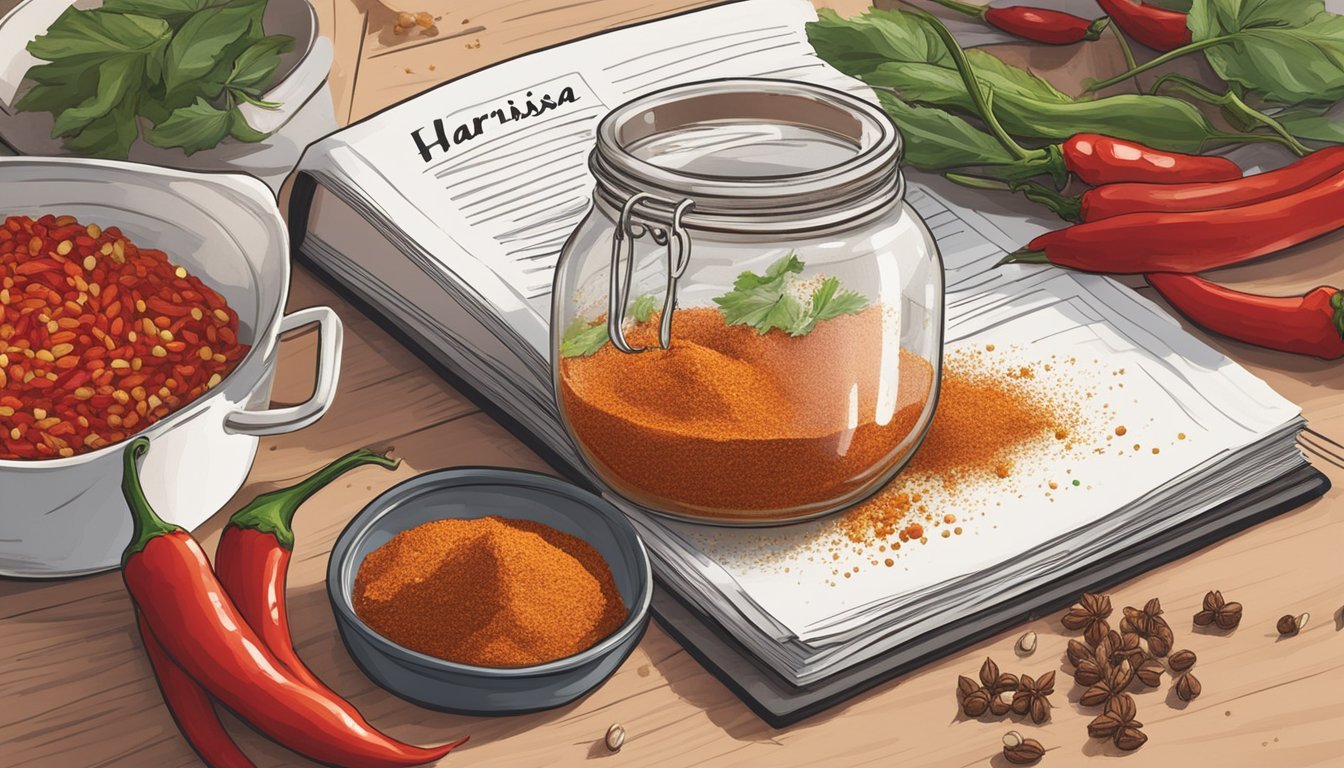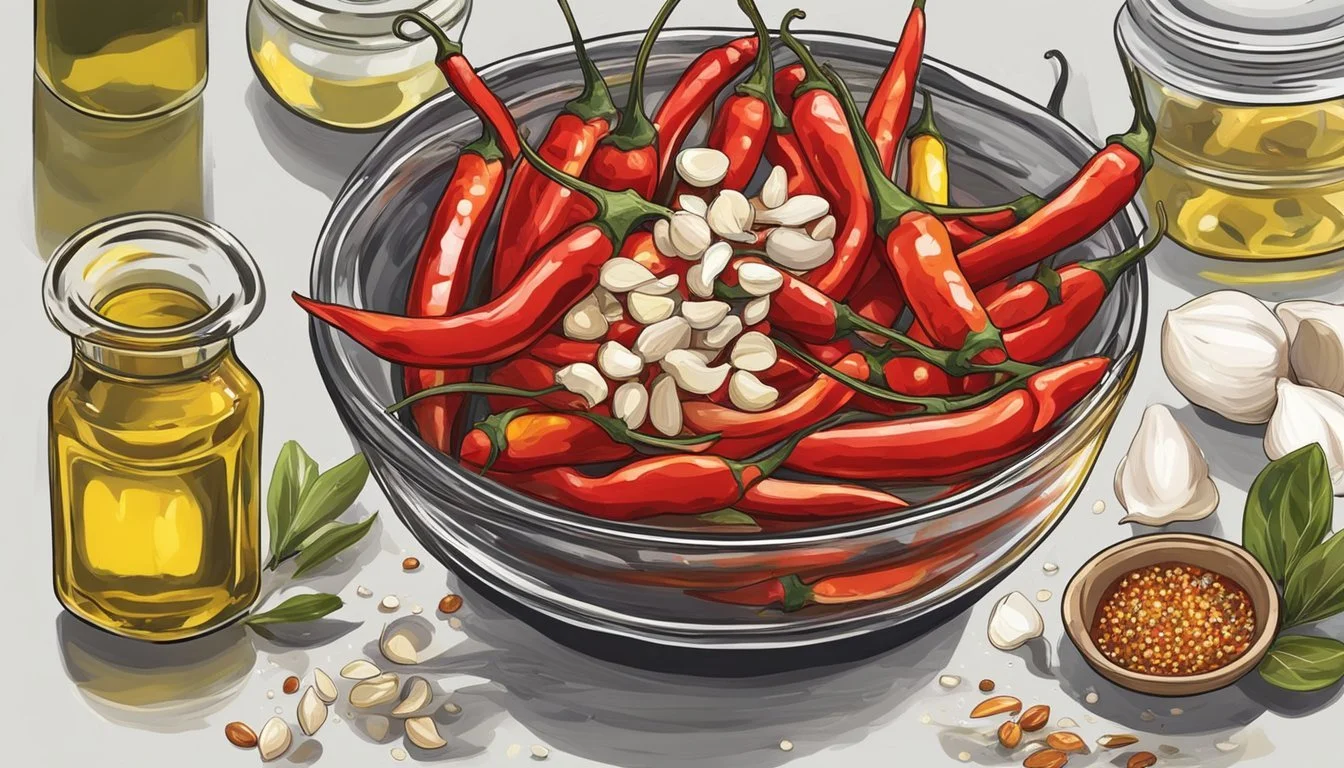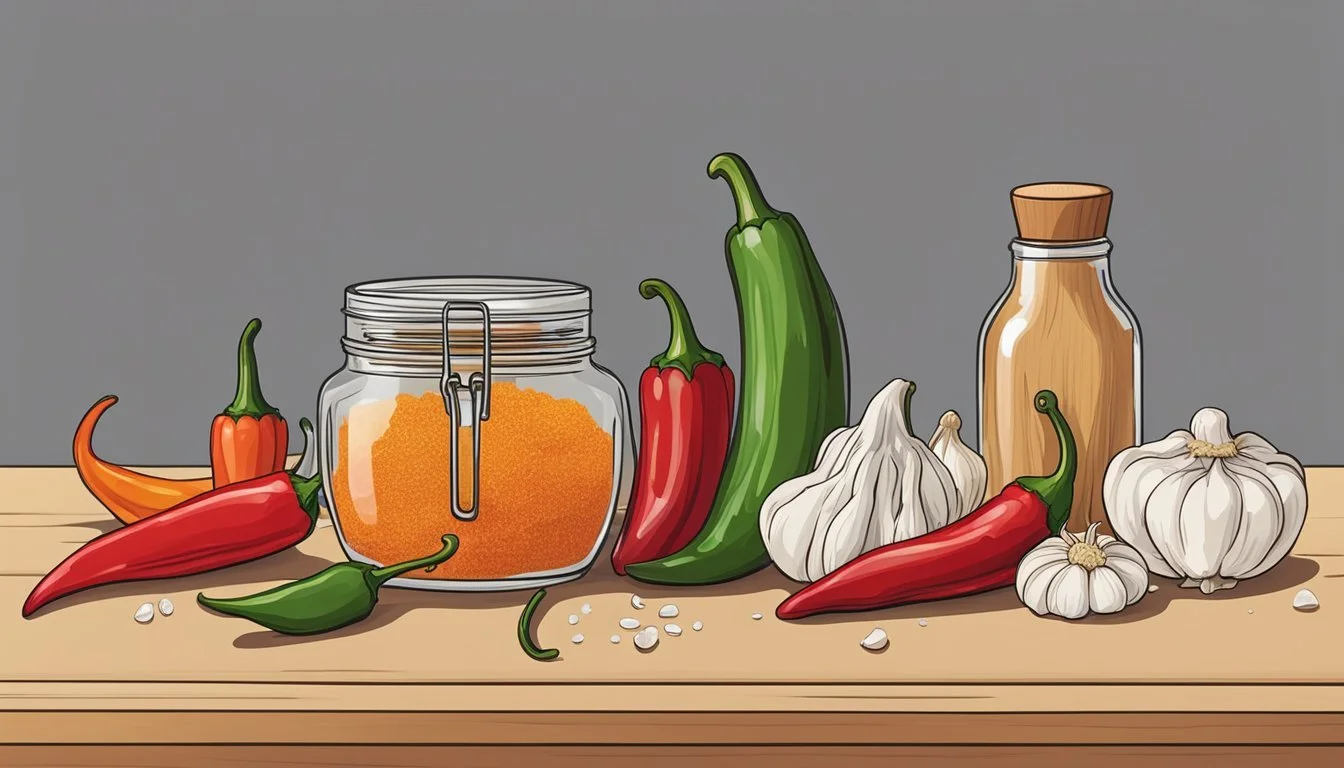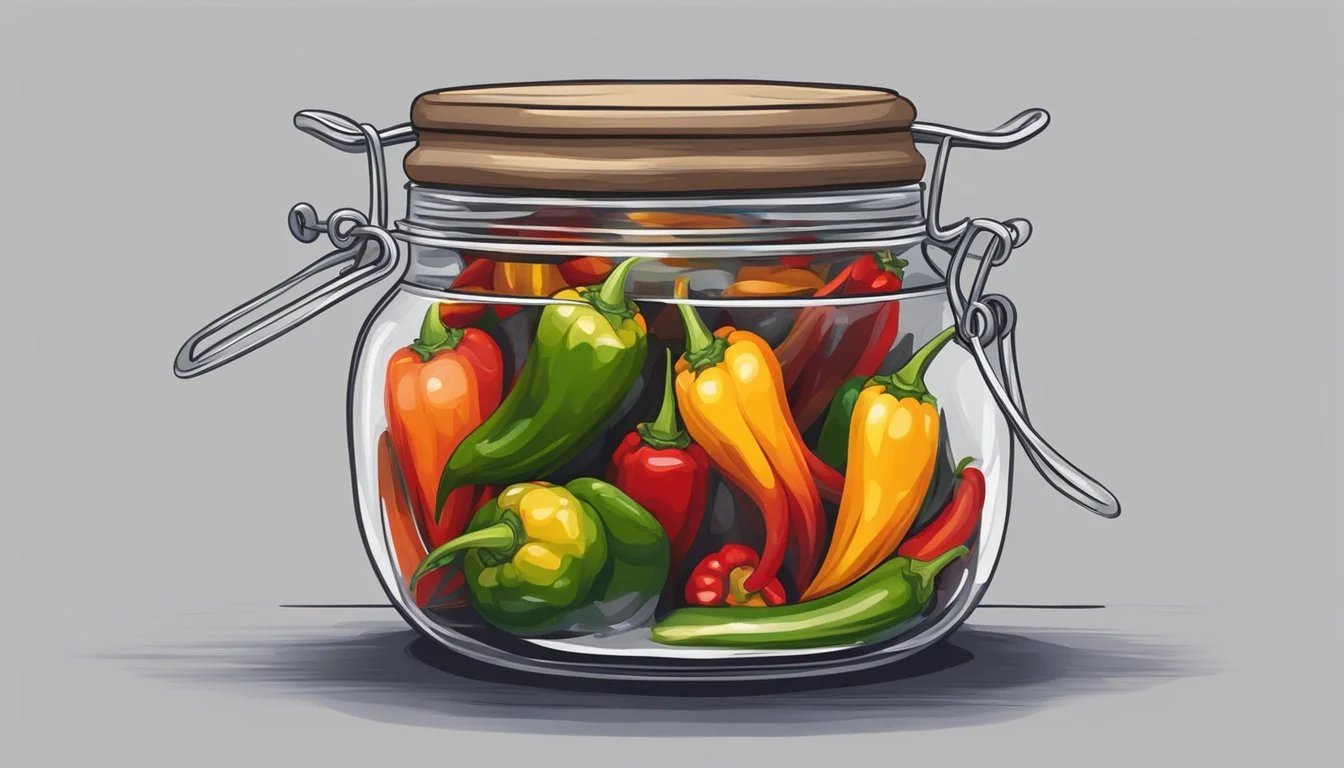How to Ferment Harissa
Mastering the Art of Fermented Chili Paste
Harissa, a spicy and aromatic chili paste, is a staple of North African cuisine, celebrated for its rich red hue and a deep, complex flavor profile. This piquant condiment traditionally combines chilies, garlic (What wine goes well with garlic?), and a blend of spices such as caraway, coriander, and cumin. Beyond its immediate use as a seasoning, harissa can also be transformed through fermentation, a process that not only enhances its flavor but also extends its shelf life, making it a versatile addition to any culinary arsenal.
The fermentation of harissa introduces beneficial bacteria, which break down the ingredients, resulting in a tangier, more nuanced taste. The technique involves submerging the paste under a brine or incorporating a starter culture such as sauerkraut juice and allowing it to ferment for a period, typically between 14 to 21 days. During this time, the mixture should be kept in a suitable environment where it can age without the risk of contamination.
As with any fermented product, attention to detail is crucial for achieving the desired outcome. Factors such as the freshness of ingredients, cleanliness of utensils, and maintenance of an appropriate fermenting environment are all essential to the success of the fermentation process. When executed correctly, the result is a fermented chili paste with a more robust and layered flavor, making harissa not just an accompaniment but a feature in its own right.
Historical Context of Harissa
Harissa, a spicy and aromatic chili paste, has deep roots in Tunisia and has been influenced by global trade and cultural exchange.
Tunisian Origins
Harissa’s journey began in Tunisia, a North African country where it is considered a staple condiment. The use of chilies in North African cuisine was an adaptation after the introduction of the New World food to the Old World, thanks to the Spanish and Portuguese in the 16th century. In Tunisia, they crafted a unique blend by mixing ground red chilies with various local spices and herbs. This paste, often homemade, has been an essential part of Tunisian gastronomy for generations.
Global Influences
The spread of harissa can be attributed to the movement of people and the spice trade. Its ingredients reflect a diverse cultural influence; for example, the use of spices like cumin and coriander harks back to the Arab and Mediterranean trading heritage. As North African cuisine gained popularity over the centuries, harissa found its place in the global culinary scene. It is now embraced in various forms and recipes, often adjusted to suit the taste preferences of different regions.
Essential Ingredients
Creating the perfect fermented Harissa hinges on the right choice of high-quality ingredients, each component striking a balance of flavor and preservative qualities to ensure a successful ferment.
Choosing the Right Chili Peppers
The type of chili peppers used can greatly influence the flavor and heat level of Harissa. Home cooks should look for fresh, vibrant chilies that are free of blemishes. Dried chiles are also an option and should be soaked in hot water to rehydrate before use. A mix of both sweet and spicy varieties results in a rich, complex heat profile.
Sweet Varieties: Bell pepper, Ancho, or Poblano
Spicy Varieties: Serrano, Cayenne, or Arbol
Spices and Aromatics
Spices are pivotal in crafting Harissa's signature flavor. They should be fresh, aromatic, and, when possible, toasted to draw out their oils and intensify their taste. Aromatics like garlic add depth and savoriness to the paste.
Spices:
Caraway seeds
Coriander seeds
Cumin seeds
Aromatics: Fresh garlic cloves
A traditional method involves dry roasting caraway, coriander, and cumin seeds over medium heat until fragrant, which takes approximately 4-5 minutes.
Balancing Salt and Oil
Salt is not only a flavor enhancer but also serves as a preservative during fermentation. The correct proportion of salt is crucial; too much can inhibit fermentation, and too little can allow unwanted bacteria to grow. Olive oil adds a rich flavor and helps preserve the Harissa's color and texture.
Salt: Use non-iodized salt, such as sea salt, to avoid impurities that can impede fermentation.
Olive Oil: Adds both flavor and acts as a barrier to protect the final product from oxidation.
The ratios can vary, but a starting point is about 2% salt by weight to the amount of chili and garlic mixture. Extra virgin olive oil is typically drizzled over the top of the Harissa before sealing to ferment.
Equipment and Preparation
In creating fermented harissa, one must prioritize both proper equipment and thorough preparation. These steps ensure safety and influence the quality of the end product.
Kitchen Tools Needed
To begin, the cook will require a food processor, blender, or mortar and pestle to finely chop or blend the ingredients into a paste. A sturdy glass jar or mason jar serves as the fermentation vessel. Depending on the quantity of harissa being made, multiple jars may be necessary.
Food Processor/Blender: For efficiently blending ingredients into a smooth paste.
Mortar and Pestle: Optionally used for more control over texture.
Glass Jar/Mason Jar: For the fermentation process; with a tight-fitting lid.
Cleaning and Sanitizing
Before starting, they must clean and sanitize all equipment. This includes thoroughly washing the jars, lids, food processor, blender components, and any other utensils with hot soapy water. Afterwards, these items should be rinsed with boiling water or a suitable food-grade sanitizer to eliminate any potential contaminants.
Pre-fermentation Prep
The ingredients should first be prepared by removing stems, peeling garlic, and deseeding peppers if a milder harissa is desired. The cook should strictly follow recipe instructions for the correct proportions and ingredient preparation before adding them to the food processor or blender for blending or to the mortar for grinding. Regardless of method, obtaining a consistent paste is key. The cook should then transfer the paste into the sanitized jars, pressing it down to minimize air pockets, and seal the lid firmly to not have space for unwanted bacteria.
Fermentation Process
Fermenting Harissa is a process that harnesses the power of beneficial bacteria to preserve chili peppers and enhance their flavors. It requires careful attention to creating the correct environment, diligent monitoring, and understanding the timeline of the fermentation stages.
Creating the Right Environment
To successfully ferment Harissa, one begins by ensuring the mixture has the right salinity. The brine, a solution of water and salt, plays a crucial role by creating an environment conducive for lacto-fermentation. The salt concentration should be sufficient to suppress the growth of unwanted bacteria while promoting the activity of beneficial lactobacillus bacteria. The general rule is to use 2-5% salt by weight of the total ingredients, including water. Moreover, one should fill the mixture into a clean, sterilized jar while mindful of leaving headspace—an inch or two at the top to allow for expansion as gases form.
Monitoring the Fermentation
During the fermentation process, the Harissa paste should be checked regularly for signs of activity, such as the formation of air pockets or changes in aroma. The fermenter must occasionally "burp" the jar—gently opening it to release gases that accumulate as a natural part of the fermentation process. This practice prevents the risk of pressure buildup that could cause the jar to break. The presence of bubbles or a slight tangy smell typically indicates a healthy ferment.
Duration and Stages
The length of time required to ferment Harissa can vary between 14 to 21 days, depending on factors like room temperature and desired flavor intensity. During the early stages, one should observe a marked increase in fermentation activity. As it progresses, the activity will slow, and the Harissa will develop a more complex, robust flavor profile. Once fermentation is complete, the Harissa can be stored in the refrigerator to slow further fermentation and maintain its quality.
Storing and Preservation
After fermentation, proper storage is crucial to maintain the harissa's quality and safety. Refrigeration and airtight containment are key, as is vigilance against mold to ensure extended enjoyment of the chili paste.
Refrigeration Guidelines
Upon completion of the fermentation process, harissa should be stored in the refrigerator. The colder temperature halts fermentation and preserves the chili paste's flavor and texture. It is recommended to transfer the harissa into sterilized jars before refrigerating to reduce the risk of contamination. The paste should be kept in the fridge at or below 4°C (39°F) to ensure safety and quality.
Extending Shelf Life
To maximize the shelf life of fermented harissa, ensuring an airtight seal on storage jars is essential. Any exposure to air can introduce unwanted bacteria that spoil the paste. For additional protection, one can pour a thin layer of olive oil on top of the harissa before sealing, which acts as a natural barrier against air and contaminants. When stored properly, refrigerated harissa can last for several months.
Identifying and Preventing Mold
The presence of mold on fermentations like harissa can be both unsightly and unsafe. Regular checks are important for early detection of any mold growth. Mold typically appears as a fuzzy or slimy layer on the surface, and can be various colors. If mold is spotted, the affected portion should be removed immediately. To prevent mold, one should always use clean utensils when handling harissa, keep the paste submerged in brine, and ensure jars are sealed tightly.
Culinary Uses of Harissa
Harissa's versatility as a condiment makes it a vital ingredient in numerous dishes, offering a distinctive kick with its complex blend of flavors. Below, explore the traditional and inventive ways to incorporate this spicy paste into various recipes.
Classic Recipes and Pairings
Harissa traditionally enhances the flavor of stews and soups, bringing a robust depth and heat to these comforting dishes. One might whisk it into broths or mix it into the base of a stew to create a piquant foundation. Fish dishes often benefit from harissa's smoky qualities, either when used as a rub before cooking or as a spicy addition to a sauce, complementing the delicate flavors of the seafood.
Soups & Stews: Incorporate a teaspoon or more to taste for a spicy undercurrent.
Fish: Brush onto fillets before cooking or stir into accompanying sauces.
Innovative Harissa Fusions
Chefs have been known to blend harissa with other ingredients to create innovative fusions. A popular example is the combination of harissa with mayonnaise to make a fiery spread for sandwiches, burgers, and as a dip. The paste's versatility extends to various international cuisines, seamlessly integrating into dishes that call for a hot sauce with a more nuanced profile.
Harissa Mayo: Combine equal parts of harissa and mayonnaise.
Global Cuisine Fusion: Employ harissa's kick in place of other hot sauces.
Dips and Marinades
This Tunisian chili paste serves excellently as a base for dips and marinades, often providing a spicy undertone to creamy textures like hummus or yogurt-based sauces. When used in marinades, harissa not only imparts heat but also infuses proteins with its complex flavors, ensuring a rich taste in every bite.
Dips: Stir into hummus or yogurt for an elevated flavor experience.
Marinades: Blend with olive oil and marinate meats prior to cooking.
Health Benefits and Nutritional Information
Fermented Harissa is not only flavorful but also brings a wealth of nutritional benefits. It contains vitamins and minerals essential for health and has a calorie makeup that should be considered in a balanced diet.
Vitamin and Mineral Content
Harissa is rich in vitamin C, providing a substantial percentage of the daily recommended intake. This vitamin is crucial for immune system function, skin health, and iron absorption. Additionally, Harissa contains other minerals that benefit overall health, although specific quantities can vary based on the recipe.
Caloric Considerations
A single tablespoon serving of Harissa typically has a calorie count that's relatively low, making it a flavorful addition to meals without adding a significant amount of calories. It's important to note that the caloric content can vary depending on the specific ingredients used and their proportions.
Tips and Tricks for Perfect Harissa
Creating the ideal Harissa requires attention to the balance of heat, color, texture, and flavor. This section offers specific advice on how to optimize these elements for a rich and satisfying fermented chili paste.
Adjusting Heat Levels
To modulate the spiciness of Harissa, chefs can alter the type and quantity of chilies used. For a milder Harissa, one might incorporate seeded bell peppers (What wine goes well with bell peppers?) combined with a smaller amount of hot chilies. Conversely, to increase the heat, one would add more hot chilies such as serranos or habaneros, or include seeds for an extra kick.
Mild Heat Configuration:
Bell peppers: 70%
Hot chilies: 30%
Intense Heat Configuration:
Hot chilies: 70%
Seeds included: Yes
Enhancing Color and Texture
The visual appeal and mouthfeel of Harissa are as important as its taste. The addition of tomato paste can boost the red hue while thickening the paste. To achieve a smoother texture, blending the ingredients thoroughly until completely puréed is key. For a more rustic texture, one can briefly pulse the mixture to leave slightly larger chunks.
For Richer Color:
Tomato paste: 2 tablespoons
For Smooth vs. Rustic Texture:
Smooth: Blend until puréed
Rustic: Pulse to desired chunkiness
Flavor Variations
Harissa's flavor profile can be customized through the incorporation of various additional ingredients. Lemon juice adds a tangy brightness, balancing the heat and complementing the spices. For a subtly sweet and smoky note, chefs might add smoked paprika, which can be especially appealing in dishes where a smoky undertone is desired.
Suggested Additions:
Smoky Note: Smoked paprika, 1 teaspoon
Brightness: Fresh lemon juice, 1 tablespoon
Final Considerations
In the journey of creating homemade Harissa, the maker has the unique opportunity to impart personal tastes into a complex and versatile condiment. Mastery of fermentation will yield a chili paste that can beautifully complement a variety of dishes.
Customizing Your Harissa
One can adjust the flavor profile of Harissa by experimenting with different types of chilies, from mild to fiery hot, and balancing them with aromatic spices like cumin, coriander, and caraway. Texture is another aspect of Harissa that is subject to personal preference. One may choose to have a chunkier paste or a smoother, more blended consistency. The use of additional ingredients like smoked paprika or sun-dried tomatoes can add depth and complexity to the flavor.
Heat Level: Adjust the ratio of chili types.
Spices: Experiment with spice combinations.
Consistency: Blend to your preferred texture.
Add-ins: Incorporate ingredients for depth.
Harissa in Various Cuisines
While traditionally Tunisian, Harissa's application has traversed into various global cuisines as a unique and aromatic flavor enhancer. It enriches soups, stews, and marinades with its complex, piquant taste. Chefs in different parts of the world might utilize Harissa as:
A spicy spread on sandwiches
An ingredient in dressings and sauces
A vibrant rub for grilled meats or vegetables
The paste's adaptability to complement a range of cuisines underscores its potency as a homemade staple in the global pantry.







